Serena Williams – Probably the best female service of all time

Already during her active career a legend, Serena Williams (*81 / USA) has broken many records and is surely one of the very few candidates to be considered as the greatest women’s tennis player of all times. Besides her truly remarkable physical strength and an enormous winning willpower, she has also a very efficient groundstroke technique, in the distinctive details (sound understanding of the Tennis 3.0 Code) quite different from most of her competitors. Her forehand, backhand, and service/overhead can be used as almost an ideal model for the TENNIS 3.0 strokes typically strongly dominated by the energy unloading from the body. Serena’s service has then been one of her biggest and most reliable weapons over the course of her 20+ years long stellar career.
Below, I am presenting the analysis of Serena’s service during the 2018 Wimbledon Championships while also adding few images from far back in 2003. It is interesting to see that her core service fundamentals have been quite the same in 2003 already and this speaks for the quality of her coaching back then and mainly even before that. In short, Serena’s service is very simple, well-focused at the decisive elements (not always quite clear to many in the tennis world) and practically free of any potentially disturbing idiosyncrasies. Some of the main decisive elements to be mentioned are a relaxed well-balanced starting platform position, a very stable quite high toss, a delayed loading/backswing on a long trajectory, a perfect eye control of the impact zone, a massive well-timed push-off, a significant shoulder and elbow elevation and a very good energy unloading into the well-controlled targeted long-axis pronation (= internal shoulder rotation). In summary, the remarkable power, as well as the control, of Serena’s service is being developed in a good balance of action in all 3 dimensions (vertical, horizontal, rotational). This is what I call the “helix stroke” and in this case the “helix service” and what I consider as the overall deciding element making, from the performance point of view, the real tennis greatness possible. As with all the helix strokes, the forward (horizontal) action delivering the energy against the target is dominant, but its coordination with the well-timed actions in the other 2 dimensions (vertical, rotational), without disturbing the main power axis, is for the top overall quality and sustainability of the stroke inevitable.

Serena Williams (*1981 / USA) – 1st service 3.0 in a match – ace from the deuce side – 1 of 1 – follow through 1 – end – the stored energy was well unloaded into the long-axis targeted pronation (actually internal shoulder rotation) – a perfect documentation of the well-combined action in all 3 dimensions (vertical, horizontal, rotational) = a classy “helix service” – 2018 Wimbledon – London / United Kingdom aka Great Britain
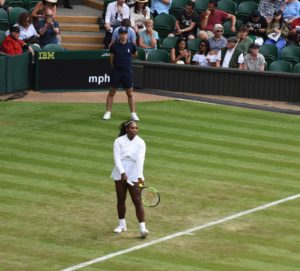
Serena Williams (*1981 / USA) – 1st service 3.0 in the match-warm-up – deuce side – 1 of 10 – start – relaxed and well-balanced in a wide platform stance, most of the body weight is on the back foot – 2018 Wimbledon – London / United Kingdom aka Great Britain

Serena Williams (*1981 / USA) – 1st service 3.0 in the match-warm-up – deuce side – 2 of 10 – toss/ball release – with a straight non-dominant (left) arm and under a perfect eye control, the ball is being released above the head level, clearly delayed backswing – 2018 Wimbledon – London / UK

Serena Williams (*1981 / USA) – 1st service 3.0 in the match-warm-up – deuce side – 3 of 10 – loading/backswing 1 – weight is being transferred to the front foot, the tossing arm keeps stable position while pointing at the tossed ball – 2018 Wimbledon – London / UK

Serena Williams (*1981 / USA) – 1st service 3.0 in the match warm-up – deuce side – 4 of 10 – loading/backswing 2 – racket goes back on a long trajectory, which implies together with the delayed backswing start a higher toss, tossing arm and eyes/head remain very stable – 2018 Wimbledon – London / UK

Serena Williams (*1981 / USA) – 1st service 3.0 in the match-warm-up – deuce side – 5 of 10 – loading 3 – well-controlled transfer from the platform into the pinpoint stance, perfect posture and eye control – 2018 Wimbledon – London / UK

Serena Williams (*1981 / USA) – 1st service 3.0 in the match-warm-up – deuce side – 6 of 10 – push-off 1 – the racket is on its way into the cocking position, the tossing (left) arm starts to descend – 2018 Wimbledon – London / UK
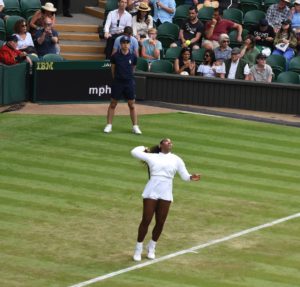
Serena Williams (*1981 / USA) – 1st service 3.0 in the match-warm-up – deuce side – 7 of 10 – push-off 2 – the racket is about to reach the cocking position – 2018 Wimbledon – London / UK
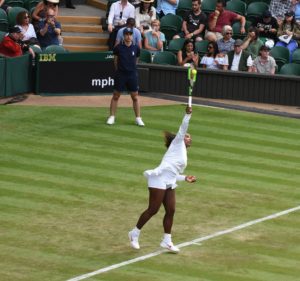
Serena Williams (*1981 / USA) – 1st service 3.0 in the match-warm-up – deuce side – 8 of 10 – impact – practically ideal high reach with a significant shoulder and elbow elevation, perfect head stability with eyes still directed at the impact zone – 2018 Wimbledon – London / UK

Serena Williams (*1981 / USA) – 1st service 3.0 in the match-warm-up – deuce side – 9 of 10 – follow through 1 / landing – end of the body energy unloading into the targeted long-axis pronation – 2018 Wimbledon – London / UK
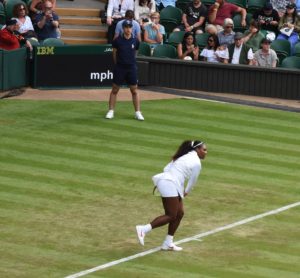
Serena Williams (*1981 / USA) – 1st service 3.0 in the match-warm-up – deuce side – 10 of 10 – follow through 2 = relaxation – 2018 Wimbledon – London / UK
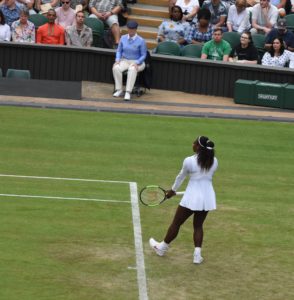
Serena Williams (*1981 / USA) – 1st service 3.0 in a match – deuce side – 1 of 7 – start – well-balanced and relaxed in a wide platform stance – 2018 Wimbledon – London / UK

Serena Williams (*1981 / USA) – 1st service 3.0 in a match – deuce side – 2 of 7 – toss/backswing – very calm tossing arm, while loading, the transfer from the platform to the pinpoint stance is being initiated – 2018 Wimbledon – London / UK

Serena Williams (*1981 / USA) – 1st service 3.0 in a match – deuce side – 3 of 7 – loading 2 – tossing (left) arm and head are very stable – 2018 Wimbledon – London / UK

Serena Williams (*1981 / USA) – 1st service 3.0 in a match – deuce side – 4 of 7 – push-off 1 – racket is traveling into the cocking position – 2018 Wimbledon – London / UK

Serena Williams (*1981 / USA) – 1st service 3.0 in a match – deuce side – 5 of 7 – push-off 2 – short before the impact – a significant shoulder and elbow elevation, a perfect eye control of the impact zone – 2018 Wimbledon – London / UK
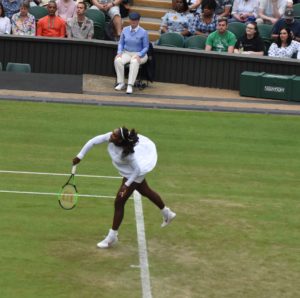
Serena Williams (*1981 / USA) – 1st service 3.0 in a match – deuce side – 6 of 7 – landing/follow through 1 – end – perfect body energy unloading into the targeted long-axis pronation – hitting (right) palm still points to the outside – 2018 Wimbledon – London / UK

Serena Williams (*1981 / USA) – 1st service 3.0 in a match – deuce side – 7 of 7 – landing/follow through 2 = relaxation – eyes are focusing at the returing player – 2018 Wimbledon – London / UK
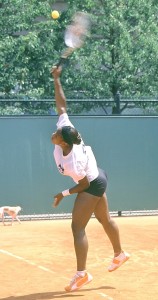
Serena Williams (*81 / USA) – 1st service in the practice – 1 of 1 – moments before impact – excellent high reach and eye control of the impact zone – 2003 French Open – Paris / France

Serena Williams (*81 / USA) – 1st service in the practice – 1 of 1 – follow through 1 – end – perfect energy unloading into the long-axis targeted pronation, the palm of the dominant (right) hand still points to the outside, excellent body posture control – the 3D helix action is well-visible – 2003 French Open – Paris / France
This article covers certain aspects of Serena Williams’ service and service in general only! Further extensive photo galleries and more distinct details about her service and other strokes as well as about the strokes of other players are available upon request at drmgb11(at)gmail.com. Some significant details of this kind, necessary for the peak performance in modern tennis as well as for a sustainable tennis training/development in general, are being discussed also in the seminar “TENNIS 3.0 – Future of the Game”, which is available worldwide upon request – www.tennis30.com / www.tennis30.cz
Photos (June 2003 & July 2018) & text (October 2018) copyright by Dr. Martin G. Baroch. Any further publication of either any of the photos and/or texts with the explicit written permission issued by the author/copyright owner only!! All instruction provided reflects just the personal opinion of the author and neither the author nor the CPTA accepts any responsibility for potential damages of any kind!!



